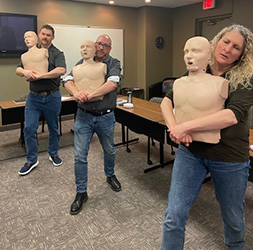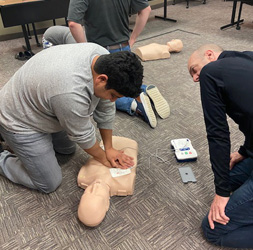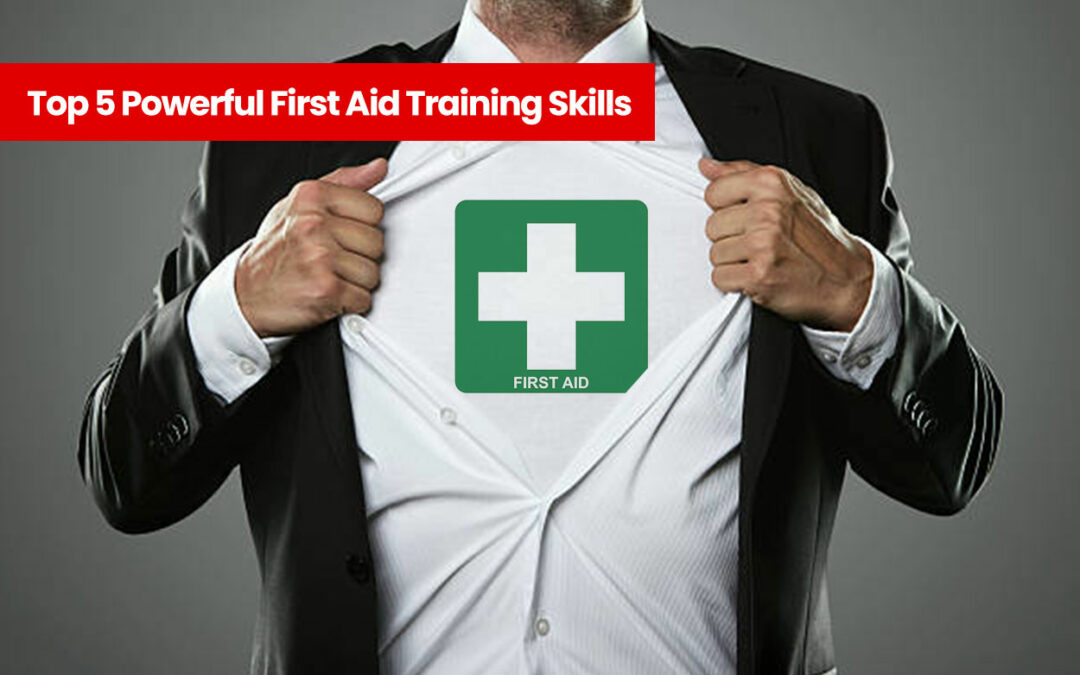The Top 5 First Aid Training Skills Everyone Needs to Master
In today’s fast-paced world, accidents and emergencies can happen at any time. Being prepared with essential first aid skills can make a world of difference in the event of an emergency. With the power of first aid training, we emphasize enough the importance of knowing some basic life-saving techniques. In this blog post, we will outline five crucial first aid skills that everyone should learn.
Let us prepare your company and employees for any emergency situation.
View our list of comprehensive SOS Oxygen & OHS Programs and First Aid Training:
Alberta
British Columbia
Online Courses
1. CPR (Cardiopulmonary Resuscitation)
In today’s fast-paced world, accidents and emergencies can happen at any time. Being prepared with essential first aid skills can make a world of difference in the event of an emergency. With the power of first aid training, we emphasize enough the importance of knowing some basic life-saving techniques. In this blog post, we will outline five crucial first aid skills that everyone should learn.
In the Workplace: The importance of CPR in the workplace cannot be overstated. In a professional environment, accidents and medical emergencies can occur at any time, putting employees’ lives at risk. Equipping staff with the knowledge and skills to perform CPR can be the difference between life and death in such situations.
By investing in CPR first aid training for employees, businesses can help create a safer work environment, promote a culture of preparedness, and potentially save lives. Furthermore, knowing that colleagues have CPR skills fosters a sense of community and teamwork, as employees are reassured that their coworkers are ready to step in and help during an emergency. In essence, CPR training in the workplace is not only a wise investment in employee safety but also a crucial component in fostering a supportive and resilient work community.
See our First Aid Training in action:
2. Treating Bleeding
First aid training is essential in teaching individuals how to address various medical emergencies, including bleeding. When it comes to treating bleeding, first aid training equips individuals with the knowledge to react quickly and effectively to prevent further complications. By learning to apply direct pressure, elevate the injured area, and use a tourniquet when necessary, individuals can minimize blood loss and improve the victim’s chances of recovery. Ultimately, first aid training empowers people with the skills and confidence to manage bleeding incidents, potentially saving lives in critical situations.
In the Workplace: Treating bleeding, is paramount in the workplace. Accidents involving cuts, punctures, or other injuries that cause bleeding can occur unexpectedly in various work environments. Having staff trained in first aid ensures that employees can quickly and effectively respond to such incidents, minimizing blood loss and reducing the risk of complications. Moreover, having a team that is well-versed in first aid techniques fosters a safer work environment and instills confidence among coworkers. In essence, investing in first aid training to manage bleeding incidents is crucial not only for employee safety but also for promoting a prepared, responsible, and supportive workplace culture.
 3. Choking Relief
3. Choking Relief
Choking occurs when an object blocks the airway, preventing oxygen from reaching the lungs. The Abdominal Thrust, is a simple technique that can help save a choking victim.
In the Workplace: Choking relief is a vital skill to have in the workplace, as choking incidents can occur suddenly and without warning. In environments where employees share meals or work with small objects, the risk of choking is ever-present. Having staff trained in choking relief, such as the Abdominal Thrust maneuver, ensures that employees can swiftly and effectively respond to such emergencies, potentially saving a coworker’s life.
Providing training in choking relief not only promotes a safer work environment but also fosters a sense of camaraderie and trust among colleagues. Knowing that coworkers are equipped with the skills to assist in a choking emergency helps create a supportive and responsible workplace atmosphere, demonstrating the company’s commitment to employee safety and well-being.
4. Recognizing and Treating Shock
Shock is a life-threatening condition that occurs when the body is not receiving enough blood flow. Symptoms include pale and cool skin, rapid breathing, and weak pulse. Early treatment is crucial to prevent further complications.
In the Workplace: Recognizing and treating shock in the workplace is a critical aspect of employee safety and well-being. Shock can occur as a result of various incidents, such as accidents, falls, or severe allergic reactions. Having staff trained in recognizing the signs of shock and administering appropriate first aid measures can significantly impact the outcome for the affected individual.
In the workplace, employees who are equipped with the skills to identify and treat shock can help stabilize their coworkers’ conditions and prevent further complications until professional medical help arrives. Providing first aid training in shock recognition and treatment contributes to a safer work environment, fosters a sense of teamwork, and demonstrates the company’s commitment to the overall welfare of its employees.
 5. Using an AED (Automated External Defibrillator)
5. Using an AED (Automated External Defibrillator)
An AED is a portable device that can deliver an electric shock to the heart, potentially restarting it during cardiac arrest. AEDs are becoming increasingly common in public spaces and are designed to be user-friendly.
In the Workplace: The importance of having an AED (Automated External Defibrillator) in the workplace cannot be overstated. Sudden cardiac arrest can strike anyone at any time, regardless of age or fitness level, and without immediate intervention, the outcome can be fatal. An AED is a life-saving device that can deliver a potentially life-saving electric shock to the heart, restoring its normal rhythm during cardiac arrest.
By having an AED on-site and first aid training, employees in its proper use, businesses can significantly increase the chances of survival for affected individuals. The presence of an AED in the workplace demonstrates the company’s commitment to employee safety, helps create a more secure environment, and fosters a culture of preparedness and responsibility among staff members.

